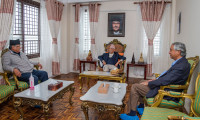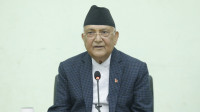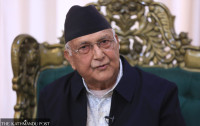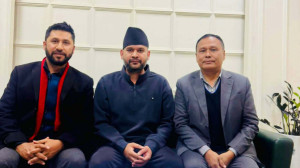Politics
Growing camaraderie between Dahal and Nepal stokes concerns in the Oli faction
Insiders say top leaders’ personal interests and ambitions will harm the party..jpg&w=900&height=601)
Tika R Pradhan
Pushpa Kamal Dahal and Madhav Kumar Nepal go back a long way.
Nepal played a crucial role during the peace process after Dahal’s Maoist party joined mainstream politics in 2006. Nepal was also actively involved in talks with Dahal multiple times to bring the Maoist party to sign a peace deal.
Now, as leaders of the Nepal Communist Party (NCP), their comradeship continues to flourish. And this growing camaraderie between the two is becoming a cause for concern for Co-chair and Prime Minister KP Sharma Oli, who has been facing criticism for his way of running the party and the government.
“There is no doubt Nepal and Dahal are very close to each other these days,” said Surya Thapa, a central committee member. “Dahal is in a bid to expand his influence in the party.”
When then CPN-UML and the Maoist party decided to merge in October 2017, Oli and Dahal had said that they wanted to create one large communist force in the country. Their joint election bid was successful; they announced unification in May last year.
But with Oli exercising full control in the party and the government, Dahal has been increasingly unhappy. And he made public a gentleman’s agreement he had reached with Oli that said both would lead the government in turn.
But before making the statement, Dahal had in April rejected Oli’s proposal to jointly select chairpersons for the party’s district committees. Again, during a June 22 secretariat meeting, Nepal refused Oli’s proposal to adopt “people’s multiparty democracy” as the party’s guiding principle. Nepal was of the view that the party should follow a political document that a taskforce led by him had prepared just before the unification announcement.
Since top leaders had agreed to go for “people’s democracy”, dropping UML’s “people’s multiparty democracy” and the Maoist party’s “21st-century people’s democracy”, Nepal insisted that everyone abide by the political document.
Leaders say these incidents show Nepal and Dahal are on the same page.
“After the unification, both Dahal and Nepal were supporting Oli,” said Ghanashyam Bhusal, a standing committee member. “But when Oli stopped consulting with leaders while taking crucial decisions, including those regarding the party unification process, it did not go down well with Nepal.”
Dahal’s discomfort emanated from Oli’s reluctance to hold discussions on government-related matters.
“This slowly brought Nepal and Dahal together,” said Bhusal.
Leaders say this bond between Nepal and Dahal can change the political dynamics in the party, which could ultimately affect the government’s functioning.
Dahal and Nepal have their own followings within the party and if they come together, they have a majority in party committees.
“This could put Oli into trouble,” said Yubaraj Chaulagain, a central member.
Leaders loyal to Oli have also time and again accused Dahal of manipulating leaders of different factions of the former UML to gain strength in the party.
Thapa, who has close relations with Oli, said the unification bid by Dahal about two years ago came after his failure to unify the Maoists.
After the 2006 peace agreement, Dahal’s Maoist party emerged the single largest party in the 2008 Constituent Assembly elections, but over the years, the party saw splits. In 2012, a group led by Mohan Baidya left while the Maoist party lost the sheen.
“After last year’s merger, we had expected Dahal to make the communist party a strong unified party,” said Thapa. “But if the recent activities are anything to go by, things don’t look good.”




 16.2°C Kathmandu
16.2°C Kathmandu















